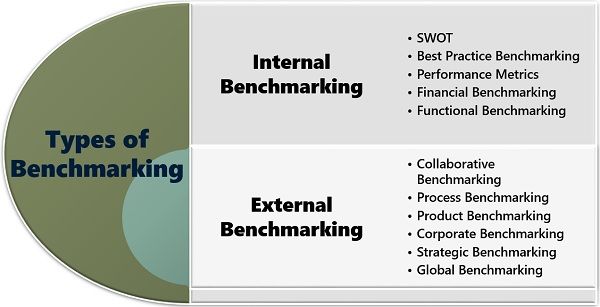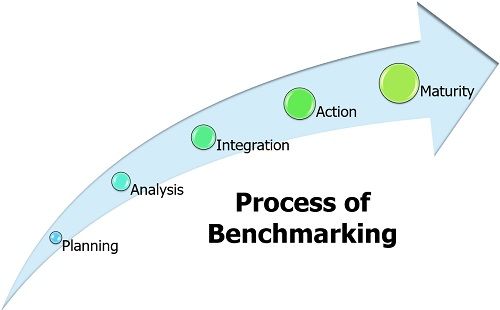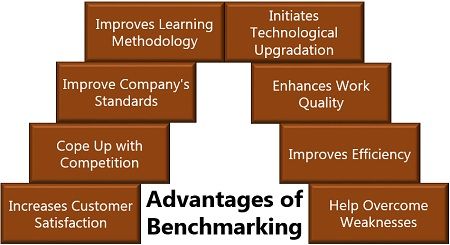Definition: Benchmarking is the process of continually improving the business or the organization by evaluating the scope for improvement, comparing the current position with that of the previous one or with the business practices of the relevant competitors, thereby establishing standards to be achieved.
For Example, A food delivery service chain was facing a problem of delay in delivery owing to customer complaints and dissatisfaction with the service.
The company prepared a team to conduct process benchmarking for this purpose. The team observed and researched on the strategy of one of its competitors who was taking the market by storm. It found that the competitive brand has installed the GPS trackers in the delivery bikes.
Thus, it can easily track the position of its delivery person and monitor their timing and efficiency.
The company followed the same strategy and was able to regain the customer’s trust over the brand and increased the level of satisfaction from its service.
Content: Benchmarking
Types of Benchmarking
Benchmarking is a strategic activity. It requires a lot of research and analysis. To make it efficient, the company must be clear about the type of related strategy it must adapt to treat a specific problem area.
It is bifurcated into the following two categories each of which holds some strategies:
To understand each of its types in detail, read below.
Internal Benchmarking
The internal benchmarking refers to the comparison of the organizational performance internally. Either with its previous performances or with that of its competitors, i.e., the companies belonging to the same industry. Here, the information is usually gathered and circulated within the organization itself.
Following are the various strategies falling under this category:
- SWOT: In this benchmarking strategy, the strengths, weaknesses, opportunities and threats of the company are listed out and analyzed by the management.
- Best Practice Benchmarking: The management themselves studies and identifies the strategies and practices of the other companies who are the market leaders, to plan the desired course of action.
- Performance Metrics: This strategy is based on the statistical metrics derived through the analysis of the client’s preference and the comparison made with competitors. The company can find out the loopholes in its performance and work over it.
- Financial Benchmarking: The management conducts a comparative study of the financial forecast with the actual results or financial reports to find out the areas of shortcomings and take corrective actions.
- Functional Benchmarking: The company compares its performance and products with that of other related industries to innovatively improve its functionality.
External Benchmarking
In external benchmarking, the companies compare their performance with that of its competitors in the industry or across the globe. Usually, by the data collected through associations or third party.
To know about the different external strategies in detail, read below:
- Collaborative Benchmarking: To improve the performance standards, the companies belonging to a particular industry collaborate with the industrial associations. These associations provide the benchmarking data on best practices and a comparative analysis of all the companies, to facilitate the improvement of the underperforming companies.
- Process Benchmarking: In process benchmarking, the company analyzes the competitor’s methods, tasks, techniques of production, means of distribution, etc. It also studies the standard mechanisms of performing a particular function, to modify its ways accordingly.
- Product Benchmarking: This strategy focuses on the in-depth analysis of the competitor’s product to know its features and composition. The company uses this strategy to improve and redesign its products.
- Corporate Benchmarking: The company compares its various departments like finance, production, distribution, marketing, human resource, etc. with those of its competitors to enhance the efficiency of each division.
- Strategic Benchmarking: This strategy is usually adopted when the company plans to implement a new policy or idea or modify the existing one. The team compares the company’s approach with that of the other successful companies in the industry before bringing it into practice.
- Global Benchmarking: It is similar to strategic benchmarking, the only difference is that here the company compares its strategies with those of its other branch or the various competitors spread across the globe, to take corrective actions.
Process of Benchmarking
Benchmarking is not an immediate solution to a problem. Instead, it is a step by step treatment of the problem area. These steps are explained in detail below:
- Planning: The planning phase determines the need for benchmarking and the area which requires it. The competitors and means to collect the relevant data are also decided at this particular stage.
- Analysis: The company then analyzes the data so gathered to find out the strengths of the competitors, list out its weaknesses and ways of improvement.
- Integration: At this phase, the analysis is reported to the top management, and after their approval, the desired action plan with a well-defined strategy, is developed.
- Action: Now, the management has a workable plan; at this stage, the employees execute the benchmarking plan.
- Maturity: The final stage is maturity; it is at this phase, where the result of using benchmarking to improve the business operations can be observed. A successful application of benchmarking will lead to the attainment of market leadership.
Advantages of Benchmarking
Benchmarking is essential for organizations to sustain high-level competition and to keep up with the customer’s requirement and needs.
Let us go through the various benefits of setting benchmarks in the organization:
- Improves Learning Methodology: Benchmarking paves the way for idea generation and sharing of proven business practices which can be seen as a learning experience for the companies.
- Initiates Technological Upgradation: Through this strategy, the companies get to know about the new technology and techniques which have been adopted by the market leaders. The companies can accordingly plan for up-gradation of its technology to sustain the competition.
- Improve Company’s Standards: The company analyzes and studies the standards of the competitors. This facilitates the company to raise its standard of production and products accordingly.
- Enhances Work Quality: It leads to organizational growth since it improves the overall quality of the output and reduces the chances of errors due to the standardization of business operations.
- Cope Up with Competition: Knowing about the competitors’ business and their strategy, helps the company to design its strategies efficiently. It also facilitates the company to be updated with the recent developments and technology, hence beating the market competition.
- Improves Efficiency: The overall efficiency of the employees increases with this practice since standardization of work motivates them to perform better without making many mistakes.
- Increases Customer Satisfaction: Through benchmarking, the company collects sufficient data on customer’s needs and wants through customer feedback. This information helps the company to enhance the customer experience and satisfaction level.
- Help Overcome Weaknesses: These strategies help the company in finding out its shortcomings and working over them to get the desired results.
Disadvantages of Benchmarking
As we already know that benchmarking requires a lot of expertise and a vast collection of data. It, therefore, becomes difficult for some organization to execute its strategies in the desired manner.
Following are some of its limitations, in this context:
- Lack of Information: Sometimes, the company is unable to gather adequate information for benchmarking. This leads to an improper or inadequate comparison of the company’s performance with that of its competitors.
- Increases Dependency: The companies tend to depend on other companies’ strategies to become successful. In this process of following the market leaders, they sacrifice their individuality and uniqueness and starts following the path shown by others.
- Lack of Understanding: At times, companies adopt benchmarking for the sake of doing so, rather than finding out the necessity of it. It fails to understand its weaknesses while keeping an eye on the functioning of its competitors.
- Copying Others: Some organizations don’t understand the actual purpose of this strategy and start copying their competitors in every aspect. This may even lead to a downfall of the business.
- Incorrect Comparison: It demands a comparison between two or more companies belonging to the same industry and competes with each other. But sometimes, the companies make irrelevant comparison resulting in poor benchmarks.
- Costly Affair: It requires a team of experienced personnel who have excellent analytical skills and expertise in the area. Thus, increasing the administrative expenses of the company. Even the implementation of the changes involves capital expenditure at times.
Scope of Benchmarking
Benchmarking is essential for enhancing the overall functioning of an organization. It is necessary for every department.
It provides for a proper supply chain management by facilitating the organization to select a well-defined distribution channel, making the flow of goods and services convenient for the consumers as well as the suppliers.
Like Amazon.in keeps on taking consumer feedback as a practice under this strategy, it has emerged as a prominent brand over the years, known for its customer service.
Tata Consultancy Services is one of the established companies which set benchmarks for its employees. It continuously works for increasing their efficiency and skills as an effective human resource management practice.
It is the best practice when it comes to operations management. The managers opt for process strategy to enhance the performance of a task or business operations like production, distribution, advertising, etc.
To implement a new plan, which may have a massive impact on the business, known as strategic management companies set benchmarks, through comparison with the successful strategy of other companies.
It is used for proper utilization of the company’s resources, including the optimum utilization of plant capacity. Product benchmarking continually focus on the improvement of the product quality and adding on new features to the existing products.
Nakala Ioane says
It really impressive and understandable appropriately..
Arshiya Najam says
Brief with clarity of knowledge and information.
Kenneth Nyongesa says
Disadvantage of Benchmarking – =Other than being a costly affair May lead to scope creep and resultant overload that doesnt add value to the business. So benchmark only that which is required by customer and business.